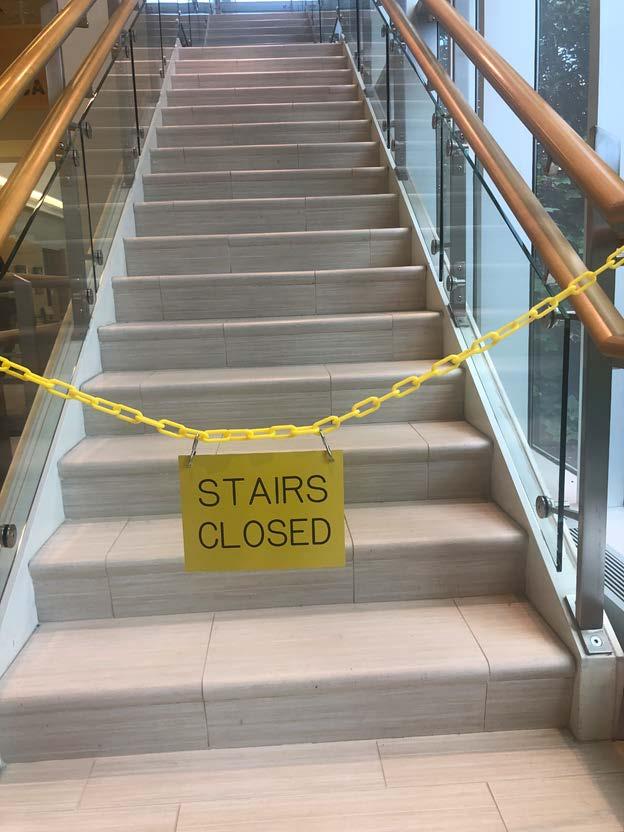
4 minute read
Resident’s Column
from PSA Sentinel Fall Issue 2020
by TEAM
Z-PAC Update
Stairway to nowhere
Advertisement
Craig Muetterties, MD Z-PAC Treasurer

I pass by this stairway every day on my way to the OR. The chain and sign are always in the same position. Each day as I pass the sign, my mind wanderers to the possible scenarios involving the stairway. I finally stopped at the security desk and inquired about the stairway. I told the security officer that it seemed like an easy way for me to get to the second floor instead of passing it and going to the end of the hall to get to the next stairway. “That stairway has never been used Doctor” explained the guard, “It leads to an area that we don’t want people to go to.”. I wondered to myself why anyone would build a beautiful staircase never to be used. I learned a lot about stairways from my oldest son. After graduating college, he got a job working for a company that sold stairways. Apparently there’s a lot more to building the stairway than meets the eye. The total rise of the stairway has to be calculated and then the rise per step needs to be put into the equation. The stairs need to be equal in height and depth so as not to cause tripping. A stairway is indeed a work of art. My son was able to fix some of the problems that builders had after they bought stairs from his employer. This became a problem since he was hired as a salesman and not a troubleshooter. The clients were quite satisfied that their problems were easily addressed by him since a significant amount of skill was involved in making the stairs correctly. Knowing some of the complexities of building a staircase, I wondered why effort and expense was put into this staircase if it was not needed or even intended to be used. I believe I have the answer. The staircase was built

without appropriate input from the people who would be using it. The builder and the client were parallel playing. The result was a perfect, beautiful staircase with no use! The side rails functioned only to hold the sign and chain blocking entry. The same thing can happen in the legislature. Rules can be made with a lack of input from the people most closely involved with their implementation. That’s exactly the function of Z-PAC -- anesthesiologists can become involved with legislators as they try to make appropriate rules with proper function. A political action group is the mechanism for sharing this information. With proper input, rules are made that have a real function and are not merely made just so that they can be made. Pennsylvania lawmakers have recently made some decisions as a knee-jerk response to a situation without adequate input. They can result in harm both to patients and the practice of anesthesiology. We need your participation in the process and support of Z-PAC in order to assure lawmakers have the input they need. Take a moment to write a check to support our PAC.
Checks can be made out to “Z-PAC” and sent to: Z-PAC P.O. Box 325 Media, PA 19063 Credit card payments can also be made by accessing the PSA website and clicking the “DONATE TO Z-PAC” tab: www.psanes.org
Reflections of a PGY1 during the pandemic

My first awareness of COVID-19 occurred during the interview trail. As I travelled from airport to airport, I noticed individuals wearing masks and gloves. The gravity of the situation had not been made clear, and I perceived the contagion as a threat similar to a “flu-like virus” –– something to be conscious of but would ultimately pass. Time passed but the virus did not. Businesses closed, events cancelled, and quarantine was in full effect. Match day celebrations were converted to social media posts, and graduation ceremonies were replaced with virtual meeting links from home. Busy cities became ghost towns and “Stay Home” was the message as this “flu-like virus” grew to become a worldwide pandemic. My co-interns and I navigated the process of moving to new cities in lockdown, meeting masked senior residents and faculty. Along with orientation to the electronic medical record system, we were oriented to the use of personal protective equipment and the importance of when to use them. As with other hospitals, UPMC implemented new policies around COVID 19. Our senior residents shared with us their experiences of working during the pandemic, and we listened with reverence and anxiety knowing we were
Boris Anyama UPMC Anesthesia PGY-1
joining their ranks. One of the biggest challenges that my colleagues and I face with patients is effectively communicating without the aid of facial expressions.
Regardless of the language someone speaks or where a person is from, a simple smile is universal. Now that is lost behind a mask. It can be scary, to be honest, to walk into a space or care for a person who has or is suspected to have COVID 19. We combat these fears by remembering the oaths we made when we became physicians. I’ve found support in my colleagues and friends, who face the uncertainties with me. Bolstered by their bravery and selflessness, I don the PPE (a luxury that I am grateful for) and approach each patient as though they were family, hoping they will be able to return home to their loved ones.
Member Benefit! Have a job you need to fill? Advertise on PSA’s Job Bank!
This job bank is specifically for employment associated with anesthesiology.






